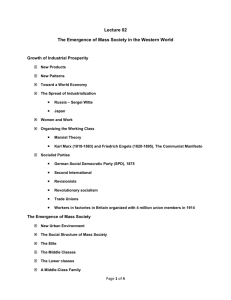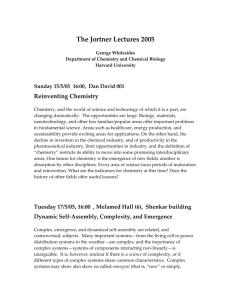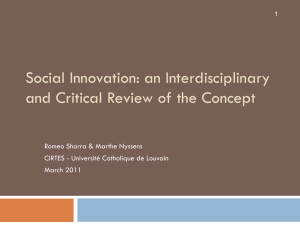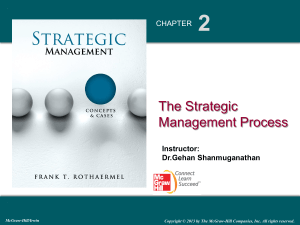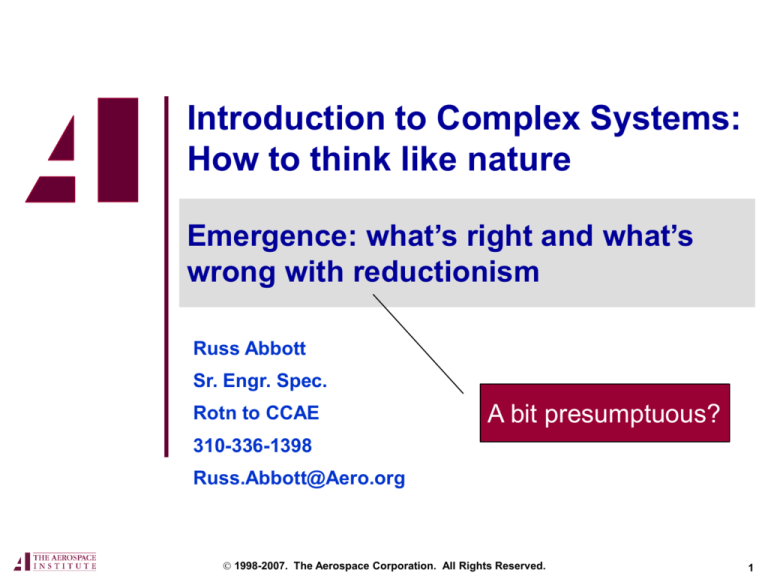
Introduction to Complex Systems:
How to think like nature
Emergence: what’s right and what’s
wrong with reductionism
Russ Abbott
Sr. Engr. Spec.
Rotn to CCAE
A bit presumptuous?
310-336-1398
Russ.Abbott@Aero.org
1998-2007. The Aerospace Corporation. All Rights Reserved.
1
Complex systems: How to think like nature
• Unintended consequences.
• Emergence: what’s right and what’s wrong with
reductionism.
2
Try it out
File > Models Library > Biology > Termites
Click Open
3
Three tabs
Interface tab:
control the model.
To run most
models, press
setup and then
go.
Press go again to
stop the run.
Information tab:
documentation
about the model
Procedures tab:
the model in
NetLogo code
Online guide: http://ccl.northwestern.edu/netlogo/docs/
4
Termite rules
• Wander about aimlessly (randomly) until
you bump into a wood chip.
• If you are not holding a wood chip
– Pick up the new chip.
– Move away from your current location.
– Go back to wandering about aimlessly.
• If you are holding a wood chip
Wikipedia commons
– Put down your held chip in a nearby empty space.
– Move away from your current location.
– Go back to wandering about aimlessly.
Net effect: wood chips are deposited near other
wood chips, eventually forming a single pile.
Run the program and watch what happens.
Wikipedia commons
Exercise: prove that this will always happen
5
Reading the code: the Procedures tab
to go
search-for-chip
find-new-pile
put-down-chip
end
to put-down-chip
ifelse pcolor = black
[ set pcolor yellow
set color white
get-away ]
[ rt random 360
fd 1
put-down-chip ]
end
to search-for-chip
ifelse pcolor = yellow
[ set pcolor black
set color orange
fd 20 ]
[ wiggle
search-for-chip ]
end
to find-new-pile
if pcolor != yellow
[ wiggle
find-new-pile ]
end
to get-away
rt random 360
fd 20
if pcolor != black
[ get-away ]
end
to wiggle
fd 1
rt random 50
lt random 50
end
6
Two levels of emergence
• No individual line of code is responsible
for making the termites behave the way
they do, i.e., to follow the rules described
two slides ago.
Wood chips in one pile
Termite behavior rules
• That the lines of code together do that is
an example of emergence.
Lines of code
• No individual rule is responsible for the
gathering of the wood chips into a single
pile.
As we’ll see later, each
layer is called a
• That the rules together bring about that
result is a second level of emergence.
level of
abstraction
Notice the similarity to layered
communication protocols
7
Let’s try another one
File > Models Library > Biology > Ants
Click Open
8
Simple ant foraging model
Ant rules
• If you are not carrying food,
• Move up the chemical-scent
gradient, if any.
• Pick up food, if any.
• Otherwise move randomly.
• If you are carrying food, move up
the nest-scent gradient. When you
reach the nest, deposit the food.
• population: number of ants
• diffusion-rate: rate at which the
chemical (pheromone) spreads
• evaporation-rate: rate at which
chemical evaporates
In “to look-for-food”, change
“orange” to “blue”.
Turns plotting on/off.
After running once, play around with
the population, diffusion-rate, and
evaporation-rate.
9
Group-level emergence
• Both the termite and ant models illustrate emergence (and multiscalarity).
• In both cases, individual, local, low-level rules and interactions
produce “emergent” higher level results.
– The wood chips were gathered into a single pile.
– The food was brought to the nest.
• Ant and termite colonies may seem different from E. coli because
we see them as groups of individual entities, often called agents.
• But emergence as a phenomenon is the same. In both cases we can
explain the design of the system, i.e., how the system works.
In Evolution for Everyone, David Sloan Wilson
argues that all biological and social elements are
best understood as both groups and entities.
http://evolution.binghamton.edu/dswilson/
10
Breeding groups/teams
Evolutionary processes are
fundamental to complex systems
Traditional evolutionary theory says there is no such
thing as group selection, only individual selection.
Bill Muir (Purdue) demonstrated that was wrong.
• Chickens are fiercely competitive for food and water.
http://www.ansc.purdue.edu/faculty/muir_r.htm
• Commercial birds are beak-trimmed to reduce
cannibalization.
• Breeding individual chickens to yield more eggs
compounds the problem. Chickens that produce
more eggs are more competitive.
• Instead Muir bred chickens by groups.
Wikipedia commons
• At the end of the experiment Muir's birds' mortality rate was 1/20
that of the control group. His chickens produced three percent
more eggs per chicken and 45% more eggs per group.
11
Emergence demystified
• As we said earlier, emergence is simply the consequence of a
design, i.e., components interacting.
• The design might be
– naturally arising, i.e., created and forged by evolution
– man-made.
• It might relate components of what would normally be considered
an entity.
– The emergent property is at the entity level.
– In might be mechanical, e.g., a clock with lots of gears.
• Or, it might relate “agents” interacting as part of what would
normally be considered a collective.
– The emergent property is at the collective level.
• Emergence doesn't necessarily imply a complicated system.
Emergence: the existence of a phenomenon that can
be described independently of its implementation.
12
One more—because it’s so famous
File > Models Library > Social Science > Segregation
Click Open
13
Credited with being the first agent-based model
• Reasonable micro-level preferences produce macro-level
segregation.
• Each agent wants the percentage of like agents to be as
indicated in %-similarity wanted.
– Similar agents/total agents. Empty neighbors ignored.
• Starts out at ~50% similar since scattered at random.
• But some are unhappy. They move to a random empty spot.
• Repeat until all agents happy.
• Easier to see if more agents. Set number to 2500 agents.
• 30%-similarity-wanted produces 75% similarity.
• 40%-similarity-wanted produces 80% similarity.
Try this.
• Set %-similarity-wanted to 75%. (Ethnic cleansing!)
• At about 2% unhappy, set it to 76%.
• Switch back and forth. An artifact of the model.
14
Lots of artifacts
• Counts only 8 neighbors.
• Can mitigate clustering (and produce stripes at
30%-similar-wanted) by adding one line.
to update-turtles
ask turtles [
;; in next two lines, we use "neighbors" to test the eight patches
;; surrounding the current patch
set similar-nearby count (turtles-on neighbors)
Want a separate slider
with [color = [color] of myself]
for %-other-wanted?
set other-nearby count (turtles-on neighbors)
with [color != [color] of myself]
set total-nearby similar-nearby + other-nearby
set happy? similar-nearby >= ( %-similar-wanted * total-nearby / 100 )
and other-nearby >= ( %-similar-wanted * total-nearby / 200 )
]
end
Sets non-similar requirement to be
half as many as similar requirement.
15
More emergence: a satellite in a geostationary orbit
In some ways the simplest possible complex system.
• The satellite is fixed with respect to the
earth as a reference frame.
• But nothing is tying it down; no cable is
holding it in place.
period of the orbit = period of the earth’s rotation
This example is typical of complex system mechanisms.
Multiple independent or quasi-independent processes
— which are not directly connected causally —
interact within an environment to produce a result.
Mechanism: ?
Function: ?
Purpose: ?
16
More emergence: E. coli (again)
• E. coli has genes to produce lactase, which
digests lactose.
• But it should produce lactase only when lactose
is present.
• Imagine that you were asked to design a system
that would produce a product only under certain
conditions.
• How would you do it?
17
A (quasi-top-down) functional analysis solution
Lactose
sensor
Off
Switch
On
Lactase
production
system
The unasked questions
• How does one know one can
build these pieces?
• What enables the interfaces?
• What holds it all together?
Is it really
top-down?
18
RNA polymerase
can’t bind to DNA.
Transcription
blocked.
Let lactose flip its own switch
lac operon
Three lac genes
RNAP
Repressor
Lactose itself binds to
the repressor, pulling
it out of the way.
lacX
lacY
lacA
RNAP
lacX
lacY
RNAP lacX
The unasked questions
• How does one know one can
build these pieces?
• What enables the interfaces?
• What holds it all together?
Nature is notoriously
bottom-up
lacA
lacY
lacA
RNA polymerase can now bind
to DNA. Transcription enabled.
The genes are expressed.
• It’s often said that a first step in systems engineering
is to agree on the system boundaries.
• What are the system boundaries in this case?
See movie http://www.biologycorner.com/bio4/notes/gene-expression.php.
19
Emergence
Naturally occurring and Designed
Entities and Groups
Naturally occurring
Entity
E. coli locomotion,
virtually any
biological entity
(including
ourselves), …
Ant/termite colony,
Group human family/tribe,
…
Human designed
Computer,
satellite,
integrated system,
…
Combination
Nation state,
chicken group,
market economy,
religious unit, …
Government,
(Multi-national)
corporation,
system of systems,
military unit (SMC),
…
…
Don’t take these categories too seriously. There is lots of overlap.
As Wilson says, everything is both an entity and a group.
20
The Game of Life
File > Models Library > Computer Science > Cellular Automata > Life
Click Open
21
Try it out
Simple rule at each cell
ifelse live-neighbors = 3
[ cell-birth ]
[ if live-neighbors != 2
[ cell-death ] ]
People love the Game of Life
because one gets amazing
complexity from a very simple rule.
Try a few runs.
• setup-random
• go-forever
What about you, me, Theseus’s ship?
• Try add-cells while it’s running.
• Zoom (Ctrl =); stop; setup-blank;
add-cells; build a glider.
• A glider is an emergent
epiphenomenon.
• What is its ontological status?
22
The Game of Life is a programmable platform
• Go to http://www.math.com/students/wonders/life/life.html
– Alternative: http://www.ibiblio.org/lifepatterns/
• Scroll down about 70% and click Run Gun 30.
• Expand to full screen before clicking Go.
Not just a component that
• Open Glider Guns.
performs a specified function
• Generates gliders with different periods.
• Zoom: 2.
• Open Primer.
• Speed: Don’t skip.
• Zoom: 0.
• Apparently implements the
Sieve of Eratosthenes.
• Can program a Turing Machine.
• Not shown here.
• Gave rise to “digital physics.”
• Nature as a cellular automaton.
• Fredkin, Zeus, and Wolfram.
23
The reductionist blind spot:
epiphenomena and downward entailment
• Can everything be reduced to physics?
– “[L]iving matter, while not eluding the ‘laws of
physics’ … is likely to involve ‘other laws,’ [which]
will form just as integral a part of [its] science.”
Erwin Schrödinger, What is Life?, 1944.
• Gliders and Game of Life (GoL) Turing Machines are
epiphenomena. (They have no causal power.)
– They are causally but not ontologically reducible.
Wikipedia Commons
– “At each level of complexity entirely new
properties appear. … The whole becomes not
only more than but very different from the sum of
its parts. Philip Anderson, “More is Different,” 1972.
Socrates
• But computability theory applies to GoL Turing Machines.
– Hence it is undecidable whether a GoL configuration will become
stable. (Downward entailment.)
– Reducing away epiphenomena produces a reductionist blind spot.
24
Complexity typically involves multiple autonomous components
• When multiple autonomous entities interact within
an environment, one often gets emergent results.
• Systems of that sort tend to be called complex.
• Poincare showed a century ago that the three-body
gravitational problem has no general solution.
• Distributed software is the most difficult to write.
• Making effective use of multi-core computers will be
the computing challenge of the next decade.
• Recall the ants and termites; the snake control
authority and the snake farmers. All are multi-agent.
• Command and Control (or organization
management) is still more art than science.
• All this contrasts with monolithic top-down control.
Derogatory terms in the complex systems world
Wikipedia commons
Imagine
having to
program
the Game
of Life.
Power to the edge!25

